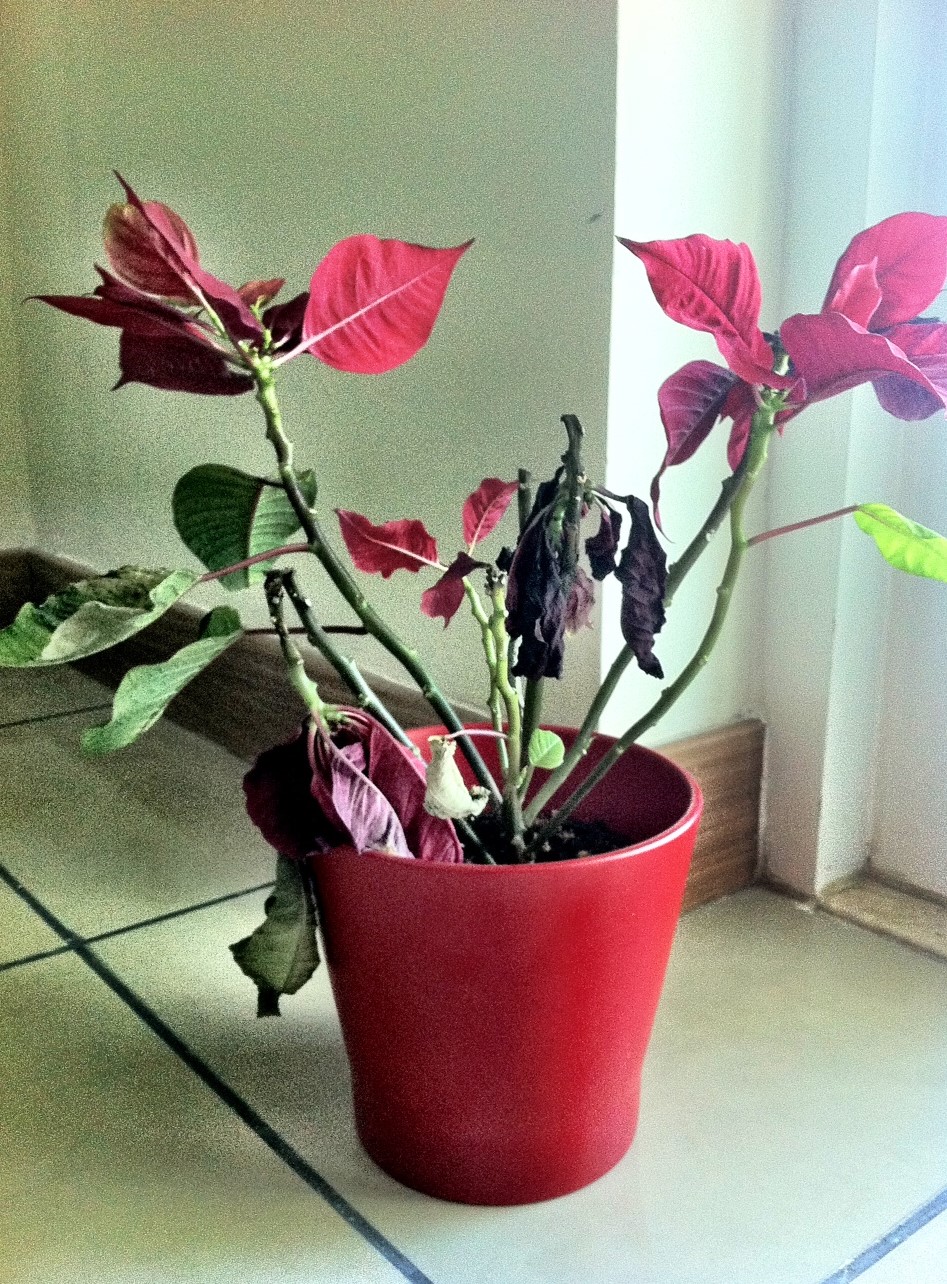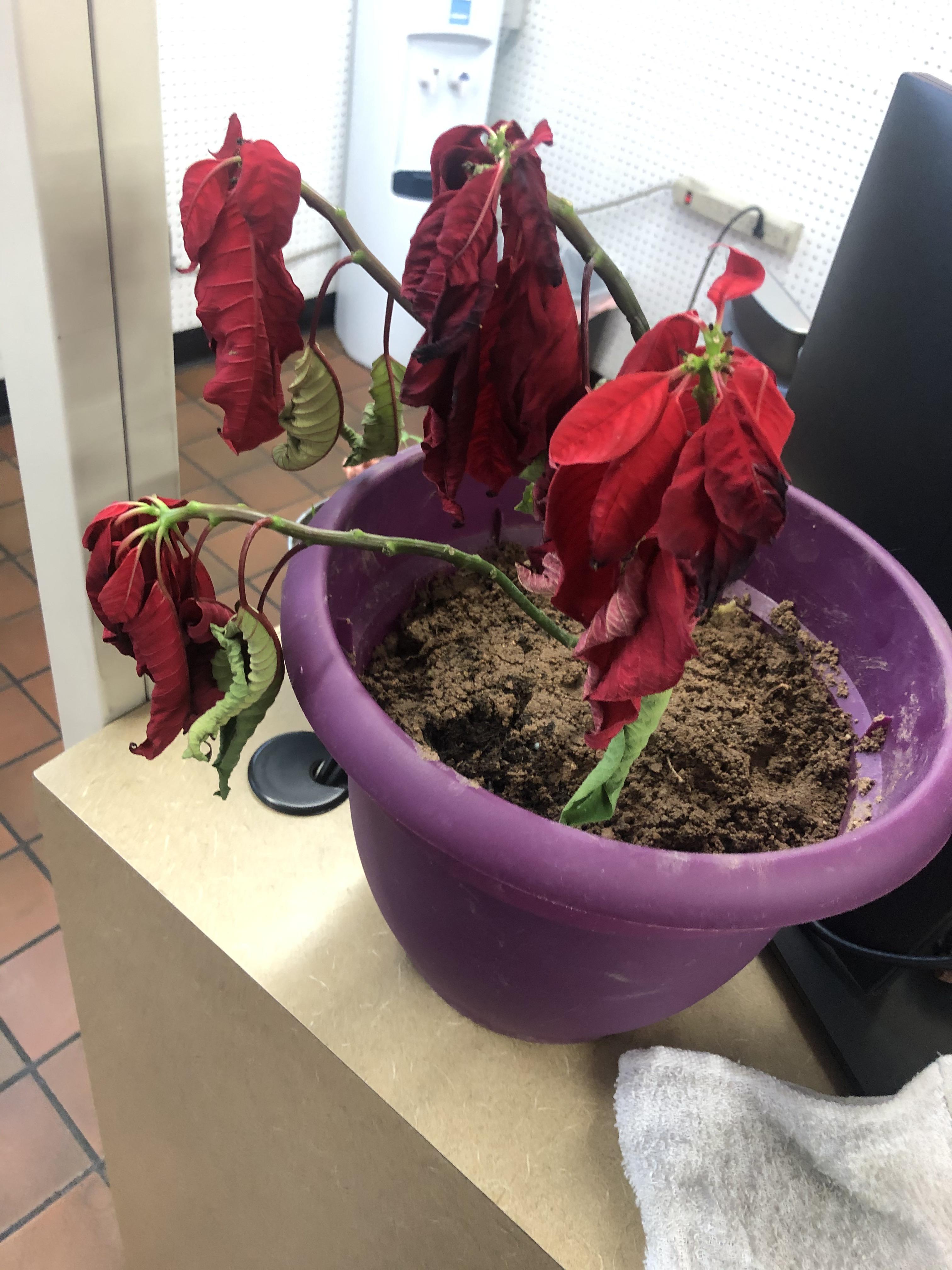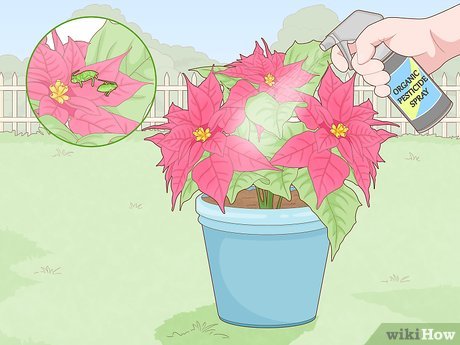When a poinsettia dies, it usually results from drought stress brought on by inadequate moisture and low humidity. Drought causes poinsettia leaves to droop and drop off with a withering appearance. Because they are not cold tolerant, poinsettias can die in temperatures as low as 60°F.
It’s crucial to mimic some of the tropical plant’s ideal growing conditions within your home in order to save a dying poinsettia.
If your poinsettia is losing leaves, wilting, turning yellow, or turning black, keep reading to learn how to revive it.
Table of Contents
Poinsettia Dropping Leaves
Your poinsettia losing leaves is most likely due to a rapid change in its growing environment or because of drought stress.
A significant change in air flow or temperature may be the cause of falling leaves.
This is a particularly prevalent issue after purchasing a poinsettia since the plant must adapt to a new environment after being grown under certain conditions, typically in a greenhouse with controlled temperature, light watering, and airflow. The plant is then relocated to the store or your home.
In particular, the stress brought on by the temperature and airflow differences is frequently to blame for the leaves on your poinsettia falling off.
Mexican-born poinsettias are ornamental plants that need constant warmth because they drop their leaves and perish in the winter.
In order to avoid this, always purchase poinsettias from reputable growers whenever possible. If the poinsettia is kept too cold while being prepared for sale at a temperature lower than 53°F (12°C) for a long period of time, the leaves drop off and the plant frequently dies back even with good care.
Potential’s watering routine is disturbed while in travel from the nursery, retailer, or warehouse to your home, and the poinsettia soil is frequently dry for a prolonged period of time, which can also cause leaves to fall.
The older leaves usually fall off in reaction to drought as the poinsettia attempts to reduce demand for moisture and limit water loss from leaves as a survival tactic in times of drought.
While some older leaves do gradually wither away over time, unexpected leaf loss is more likely an indication of stress.
How to Revive a Poinsettia that is Dropping Leaves
If the poinsettia is underwatering or experiencing mild transplant shock, it may typically be salvaged even if it is losing leaves and appears to be dying. However, exposure to really low conditions will likely cause the poinsettia to die back and make it impossible for it to recover.
The best growing conditions can be created in your home to revive the poinsettia.
- Poinsettias require nighttime temperatures of at least 55°F (13°C) and daytime temperatures of more than 60°F (15°C), with room temperature being suitable. Place your poinsettia in a warm area at all times to lessen stress on the plant.
- Place the poinsettia away from drafts, forced air, air conditioning, and anything else that could create unexpected changes in temperature. Also make sure they are not placed very close to any heat sources. The leaves drop off as a result of air currents removing their moisture.
- Because it cannot handle direct sunshine, move the poinsettia to a location with bright indirect sunlight.
- Soak the poinsettia well. Check to see if the soil is dry if the dropping of leaves is followed by yellowing and wilting of the foliage. Feel the soil at the bottom of the pot via the drainage hole to detect drought stress. A thorough soak is necessary for the poinsettia if it feels entirely dry.
- If the poinsettia has experienced drought stress, put it in a bowl of water. Sometimes soil can keep moisture from contacting its surface after it has entirely dried out. By soaking the poinsettia’s soil, you can make sure that the water will adequately permeate it and get to the roots.
- The soil should not be entirely dry or too wet for poinsettias. The ideal time to water is when the top inch of soil feels relatively dry. This water cycle replicates the environment found in Mexico, where it is endemic.
The poinsettia can adjust to its new environment with a regular watering schedule, a temperature that is steady, and indirect light.
Poinsettias are not cold resilient, though, and if they are exposed to temperatures below normal for an extended period of time, they frequently lose their leaves and begin to wither.
(I suggest reading my post on watering poinsettias to discover how to set up the best watering procedures for the circumstances in your home.)
Poinsettia Wilting and Leaves Curling
The poinsettia will dry out more quickly than its roots can absorb moisture if it is withering and its leaves are curling, which is an indicator of underwatering or low humidity.
Underwatering can result from either not watering the poinsettia frequently enough or watering it too lightly, which just moistens the top inch or two of the soil and prevents the water from penetrating and reaching the roots where it is needed.
Poinsettia are native to tropical locations and demand a little bit more humidity than other house plants, but for the ideal balance of moisture, the soil should somewhat dry out between waterings.
In an effort to reduce surface area and thus water loss, the leaves curl.
If the drought stress is milder, the leaves on your poinsettia typically wilt and curl; if the drought stress is more severe, the poinsettia typically drops leaves from the bottom.
With a little tender care, you can resuscitate the poinsettia and stop it from dying back because the leaves are curled and withered rather than necessarily all falling off.
How to Revive a Wilted Poinsettia
The poinsettia can begin to recover from its wilted appearance with the ideal watering cycle and higher humidity. After about 2 or 3 cycles of watering, the leaves should seem much healthier.
Poinsettia Turning Yellow
The most common cause of yellowing poinsettia leaves is overwatering, but it can also be caused by underwatering.
Check the dirt at the bottom of the pot through the drainage hole to determine whether it is dry or soggy to determine whether your poinsettia is yellow because it has been overwatered or underwatered.
Insufficient oxygen in the soil inhibits roots from breathing, which could lead to root rot or a fungus infection (which can also turn the poinsettia leaves black).
The leaves droop and turn yellow as a result.
– Whilst the poinsettia is wilted ensure that it is not in any direct light. … The poinsettia can acclimatize to its new surroundings if it is given a regular watering schedule, a temperature that is steady, and indirect light.
- It should be noted that poinsettias are not cold-hardy plants and will frequently lose their leaves and wither away if exposed to temperatures that are much below average for an extended period of time.
- (I suggest reading my post on poinsettia care to discover how to set up the best watering routines for your home’s environment.)
- The poinsettia will dry out more quickly than its roots can absorb moisture if it is wilting and the leaves are curling. Underwatering or low humidity is the cause of these symptoms.
A poinsettia may be underwatered if it is not watered frequently enough or if it is watered too lightly, causing the soil to only become moist to about an inch deep and preventing the water from penetrating and reaching the roots where it is needed.
How To Revive Yellow Poinsettia
- Although poinsettias, which are native to tropical locations, demand a little bit more humidity than the majority of indoor plants, the soil should somewhat aerate between waterings to maintain the ideal balance of moisture.
- To try to decrease the leaf’s surface area and prevent water loss, the leaves curl.
- In cases of milder drought stress, the poinsettia’s leaves will often wilt and curl; in cases of more severe drought stress, the poinsettia will typically drop its leaves from the bottom.
- The poinsettia can be carefully revived and kept from dying back since the leaves are withered and curled rather than necessary all falling off.
Poinsettia Turning Black
The poinsettia should not be in direct sunlight when it is wilting. The best light for poinsettias is direct, strong light. The plant can become stressed out by any direct sunshine.
Spray the plant with water to spritz it. The poinsettia’s native tropical environment is simulated by spraying the plant, which helps to produce a humid microclimate. Twice weekly, mist the poinsettia. Spraying the leaves helps to minimize water loss.
Ten minutes should be spent submerging the poinsettia in water. Water can be repelled from the soil when it dries up and prevent moisture from reaching the roots even when watered. With potting mixes that include peat soil, this is more typical. Poinsettia receives much-needed hydration and has a much better chance of recovering when the root ball is submerged in water.
More often, water your poinsettia. One weekly watering is ideal for most homes and climates. The proper watering frequency must be determined for your circumstances, though. After providing a thorough soak, water the poinsettia and then keep an eye on the soil for about a week. It is best to start watering when the top inch of the soil starts to feel a little dry, in order to keep the proper moisture balance.
Key Takeaways:
- Always use a thorough rinse. The fluid cannot reach the roots if you water too lightly. Give the pot plenty of water, letting any extra seep out the drainage holes on the bottom of the pot. This is a sign that the soil is moist in all areas and that the roots can absorb the moisture they need.
- With the ideal watering cycle and increased humidity, the poinsettia can begin to recover from its wilted appearance. After around two or three cycles of watering, the leaves should appear considerably healthier.
- It is usually a sign of overwatering, but it can also be a sign of underwatering, if the leaves on your poinsettias are turning yellow.
- Check the soil at the base of the pot through the drainage hole to determine whether it is dry or soggy to determine whether your poinsettia is yellow because it has been overwatered or underwatered.
FAQ
How do you revive a dying poinsettia?
Saline soil limits root respiration, which may result in root rot or a fungus disease. Saline soil also excludes oxygen (which can also turn the poinsettia leaves black).
Why is my poinsettia dying already?
The result is drooping and yellowing of the leaves.
Why is my poinsettia wilting and dying?
Poinsettias wilt in extreme heat and dry conditions. They should continue to flower for 12 weeks and perform best between 15 to 21 °C without any drafts. Place the pots on a pebble tray, spray the foliage, and feed frequently to prolong the blossoming and maintain the leaves in excellent condition.
Can a dying poinsettia be saved?
Remove the dead leaves from the container and the branches of a dying poinsettia before removing any additional fallen leaves. You must cut back the plant stems if they have begun to rot so that you can eliminate the dead or decaying components.
Why are my poinsettia leaves curling and falling off?
Curling, drooping, and falling leaves typically indicate that they have experienced cold temperatures or abrupt draughts. Poinsettias (Euphorbia pulcherrima), which are native to Mexico, naturally develop into towering shrubs; gardeners employ dwarfing hormones to make them into compact houseplants.



